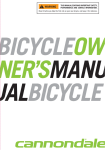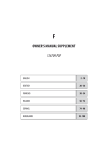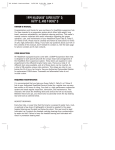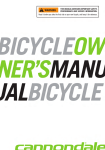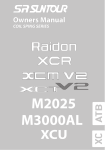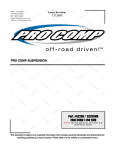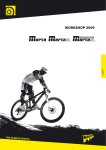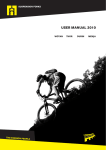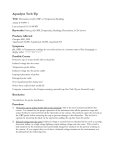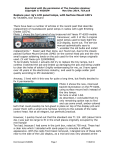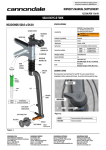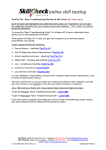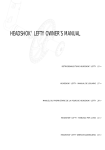Download User Manual Odin 2004
Transcript
User Manual MAGURA CCS (Cannondale Cartridge System) for Super Fatty and Super Fatty Ultra Headshok forks english Contents 1. Introduction 1.1. Magura CCS and its application 1.2. Assembly 1.3. Set-up 1.4. Before every ride 1.5. During the ride 1.6. After crash or accident 1.7. Further references 2. Maintenance and warranty 2.1. Maintenance 2.2. Warranty 3. Glossary 4. Adjustment of your MAGURA CCS 5. Data and tables 6. Exploded view of MAGURA CCS This user manual gives you detailed instructions on the set up of your MAGURA CCS Headshok cartridge. You can find more information on the web at: http://www.magura.com . If you still have questions, please send an e-mail to: [email protected] . This user manual is part of the product. Do not hand over the product to third parties without this manual. Pictures and descriptions may vary to the product being explained. Technical details are subject to change with out prior notice. Explanations Danger: This symbol means possible danger to your health and even life if you do not follow the instructions given, or if the necessary safety instructions are not followed. Attention: This symbol warns you of inappropriate handling that could lead to serious damage to the material and/or the environment. Note Icon: MAGURA Bike Parts GmbH & Co KG [email protected] Heinrich Kahn Str. 24 89150 Laichingen / Germany 0689604 Hotline/Helpdesk: [email protected] www.magura.com 1 This symbol gives you additional information about the general handling of the product or indicates paragraphs in this manual, which have to be read carefully. Descriptions and pictures can vary from the shown products. 1. Introduction Dear Customer congratulations! You have just become a member of the MAGURA mountain bike community. We believe that our Products result in a higher ride quality and hope you will enjoy our products for many years to come. Please take the time to read this manual carefully, so you can become familiar with your MAGURA part and find out how to get the best set-up for your own expectations. -RIDE HARDThe passion people 1.1. MAGURA CCS and its application MAGURA CCS Headshok cartridge is designed for Cannondale Headshok forks Super Fatty and Super Fatty Ultra with 80 mm of travel, built from year 2000 onwards. See MAGURA Techtip at www.magura.com for exact fork identification. It features external adjustable rebound damping with a Lockout. The air chamber has been increased for less progression to be able to have more usable travel. The damping is achieved by the proven shim stack piston with by pass needle. Additionally you can adjust the stem height on the steerer tube with spacers. 1.2. Assembly If you are not sure, if you can assemble the MAGURA CCS by yourself into your bike, let it been made by your professional dealer. He´s got the knowledge and specific tools for a proper assembly. If you assemble the MAGURA CCS by yourself, make sure it is compatible with your fork (only 80mm Super Fatty and Super Fatty Ultra. See MAGURA Techtip at www.magura.com for exact fork identification.). MAGURA Bike Parts GmbH & Co KG [email protected] Heinrich Kahn Str. 24 89150 Laichingen / Germany 0689604 Hotline/Helpdesk: [email protected] www.magura.com 2 Picture cartridge complete with knobs For removing the old cartridge and assembly of a new one use the MAGURA tool set 0130129 or identical Cannondale tools: pin spanner for top cap and Castle Tool HDTL146. You will also need a 2,5mm allen key for the rebound knob and a 5mm allen key for the stem. Disassemble the old cartridge (see it´s manual) from the fork structure. Don´t forget to release air on the air valve! Check for easy and smooth movement of the fork structure without play. Let the fork structure service eventually at an Authorized Cannondale Service Center. Make sure the “Race Clip” is installed, that holds the 4 races of the 88 needles at it´s place. Picture: Race Clip Inspect the inner tube threads, the outer tube threads for damage (e.g. cracked, missing, worn or stripped threads). If damage is found, replace the part with a new one. Clean and dry all threads. Remove old Loctite a make sure all threads are free of oil and grease. Apply fresh Loctite 243 on the damper cartridge threads. Don´t use the O-ring above the damper cartridge threads. This O-ring is only used on Fatty DL cartridges without external rebound adjustability. Slide the cartridge into the fork shaft. Make sure the air cap has been removed before. MAGURA Bike Parts GmbH & Co KG [email protected] Heinrich Kahn Str. 24 89150 Laichingen / Germany 0689604 Hotline/Helpdesk: [email protected] www.magura.com 3 Picture: slide cartridge Always carefully insert the castle tool. Scratch marks or nicks to the damper shaft will result in oil leaks. Avoid touching the damper shaft with the tool. Trim and glue an old tire tube or duct tape to line the tool. Thread in the cartridge with the castle tool into the inner tube. Pull out the outer cap eventually to get access to the shaft and cartridge cap. Picture: castle tool on cartridge Now thread in the outer cap with a pin spanner. Picture: pin spanner on top cap Make sure the cartridge has been completely threaded into the inner tube and the outer tube. Tighten both securely. Make sure the tools engage the slots on the caps firmly to avoid damages on the slots itself. If you want to mount spacers (MAGURA part number: 0130176, 0130177, included in the AM package) for adjusting the height of the stem on the steerer, slide them now onto the steerer. First the one with the bigger outer diameter facing downwards. Then optionally the other spacer. Then slide the stem over the steerer and tighten with correct torque (see manual of the stem). MAGURA Bike Parts GmbH & Co KG [email protected] Heinrich Kahn Str. 24 89150 Laichingen / Germany 0689604 Hotline/Helpdesk: [email protected] www.magura.com 4 Picture: cartridge threaded in with 1 or 2 spacers Slide the Lockout lever over the 6 point nut. Make sure the lever points forward, with it´s open and closed position being positioned over the stem, allowing movement of about 30° to each side. By this you avoid injuries on your knee when pedalling out of the saddle. Picture: Lockout knob on 6 point nut Position the red rebound knob over the lockout knob. Let it engage over the pin on the axle (see arrows). Tighten with counter sunk screw with allen key 2,5mm, holding the knob with your fingers, max tightening torque: 2Nm. Picture: rebound knob Pump up the cartridge (see chapter4.1 and 5) and thread in air valve cap. Lube the o-ring on the air valve cap with grease for easier turning. Picture: air valve cap An improper assembly of the cartridge in the fork can cause failure! Check (you or your dealer) mandatory for correct assembly. MAGURA Bike Parts GmbH & Co KG [email protected] Heinrich Kahn Str. 24 89150 Laichingen / Germany 0689604 Hotline/Helpdesk: [email protected] www.magura.com 5 1.3. Set-up After a correct assembly you can start fine-tuning the settings of your MAGURA CCS. You can use the following guidelines to realize a perfect set up. See the glossary in chapter 3 for explanations of the used terminology and chapter 4 for adjustments. • Your fork should sag about 15% of its total travel when you sit relaxed on your bike. When sag is less, remove preload, i.e. air, when sag is more, add preload, i.e. air. • When the fork is good on occasional bumps but gets hard after several sequential bumps, you have probably set too much rebound damping so the fork can’t return fast enough and there isn’t enough travel left to absorb the bumps. If the fork is bouncy on single impacts, then you should add more rebound damping. • If the fork dives too much, you should add some preload, i.e. air. On the other hand, if you don’t use all the travel use less air. The negative spring can be changed for different air pressure ranges depending on rider weight, to be able to achieve the correct sag. There are 4 different negative springs available: Light riders require soft negative springs, heavy riders hard negative springs. On OE equipped bikes negative springs come according to frame size (small frame Æ soft spring, large frameÆ hard spring). As MAGURA CCS aftermarket product the cartridge comes with the middle negative spring. You might change the spring to match with your rider weight. (see negative spring change on chapter 4) 1.4 Before every ride • Always wear a helmet. • Make sure the fork doesn´t have any mechanical external damages. • Make sure the fork is assembled without any play. • Check for correct air pressure. • Look for eventual leakages. 1.5. During the ride If you hear strange noises after hard impacts from your fork, that possibly could be a damage, stop riding (danger for health and life). Bring/send the fork to an authorised dealer or to a MAGURA service. MAGURA Bike Parts GmbH & Co KG [email protected] Heinrich Kahn Str. 24 89150 Laichingen / Germany 0689604 Hotline/Helpdesk: [email protected] www.magura.com 6 1.6. After crash or accident Check the fork after a crash for damages. The use of damaged or not correct working forks can cause danger for health and life. Have your fork checked by an authorized dealer. 1.7. Further references Please note that hard and out of control landings can cause severe damage to the fork with consequence danger for health and life. A non correct assembly of the cartridge in the fork can cause failure! Please check (you or your dealer) for correct assembly. Check for correct tightening torques . -> If you have doubts about the status of your MAGURA CCS please contact your dealer or ask a MAGURA Service. 2. Maintenance and warranty 2.1 Maintenance We recommend cleaning your fork on a regular basis. Use water, mild soap and a brush. Do not use a power washer as water may be forced through the seals, destroying them, the internals and piston rods. All MAGURA 2004 forks have oil damping and thus require little maintenance. They only need once a year a service. Racers should consider that they give a harder use to their components and need service more often. The oil in MAGURA CCS should be replaced every 80 hours of riding, or at least once a year. Racers should consider that they give a harder use to their components and need service more often. The seals in the cartridge require less frequent attention, and should be replaced as needed or at least every two years. These procedures require unique tools and substantial expertise and training with hydraulic suspension systems. Only an experienced mechanic at a MAGURA Passion Point or an Authorized Cannondale HeadShok Service Center should perform them. 2.2. Warranty Parts, components and assemblies subject to normal wear and tear are not covered under this warranty. MAGURA Bike Parts GmbH & Co KG [email protected] Heinrich Kahn Str. 24 89150 Laichingen / Germany 0689604 Hotline/Helpdesk: [email protected] www.magura.com 7 The warranty can expire when use according to the terms is no longer applicable. To this appropriate use also belongs the conditions for operating, maintaining and servicing as prescribed in the manual. Like every other product, the MAGURA CCS also contains parts that wear out as time passes by. The life span of these parts depend on the type and frequency of use, as well on care and maintenance. Please note that the usual wear of parts is normal and therefore no reason for objection. This especially applies to: bushings, seals and piston surfaces. Warranty duration and laws may vary from state to state and/or country to country. We point out that a warranty case can only be handled with an enclosed proof of purchase. The warranty can expire when: - Abnormal strain, neglect, abuse and/or misuse - Accident or collision damage - Application of not-original MAGURA parts and lubrication products - Incorrect maintenance - Transport damage or loss 3. Glossary Preload: Preload means the initial force on the fork springs, i.e. air chamber. Most riders would like to set the preload so that the fork sags about 15% of its maximum travel when they sit gently on their bike. For air sprung forks, like with the MAGURA CCS you must at least inflate as much air as necessary to prevent bottoming out (see chart in chapter 5.). Rebound damping: The rebound damping controls the speed of the rebound stroke of your fork. Too slow rebound makes you loose contact with the ground, which result in loss of traction and control. On the other side a too fast rebound makes the fork bounce over the ground and you will loose control as well. Rebound can be changed on top of the steerer with the red dial. Compression damping: Controls the compression stroke of the fork. More compression gives you a harder feeling, because more force is needed to compress the fork with a certain speed. As well reducing the compression damping the fork becomes plusher. Lockout: Gives you the possibility to stop the complete movement of your fork. A closed lockout eliminates movement of the fork on uphills or in a sprint. Check the position of the lockout before every ride. The lockout should not be closed on downhills or uneven ground! (Descriptions and pictures may vary from the explained product) MAGURA Bike Parts GmbH & Co KG [email protected] Heinrich Kahn Str. 24 89150 Laichingen / Germany 0689604 Hotline/Helpdesk: [email protected] www.magura.com 8 4. Adjustment of your MAGURA CCS 4.1. Air pressure adjustment 1 For air pressure adjustment, first remove the front wheel from your fork, then remove the air cap from the valve. Picture: remove cap 2 Screw the air pump onto the Schrader valve. If you have a MAGURA pump, start with part A until it is sealed, then using part B to open the valve. Now start pumping up the air chamber to the desired pressure. Press C to release air. If you reached the desired pressure, remove the pump (on the MAGURA pump first unscrew part B, then remove part A). Ensure there is grease the o-ring of the air cap and Re-install the air cap on the valve. Ensure it is screwed home completely as it prevents dirt and water getting into the fork structure. 4.2. Rebound damping adjustments MAGURA CCS cartridges allow 'On-the-fly' adjustment of the rebound damping by means of the red knob located in the centre of the larger Lockout knob. Turning the small red knob all the way counterclockwise (“-“) adjusts the damping to its most open, compliant setting (minimum damping). Conversely, turning the knob clockwise (“+”) will increase the damping. The red rebound damping knob is only for adjustment, it does not lock out the suspension action (the larger black knob controls the lockout.) 4.3. Lockout Your MAGURA CCS feature suspension lockout, allowing the rider to turn the shock absorber on or off as desired 'On-the-fly.' The black Damping Dial located atop the MAGURA Bike Parts GmbH & Co KG [email protected] Heinrich Kahn Str. 24 89150 Laichingen / Germany 0689604 Hotline/Helpdesk: [email protected] www.magura.com 9 fork is turned clockwise to lockout the suspension action of the fork, or turned counter-clockwise to activate the suspension. Picture: LO knob 4.4. Compression damping Additionally, the MAGURA CCS have high speed (big impact) compression damping which is adjustable by changing valve shims within the hydraulic cartridge. The negative spring can be changed to suit your rider weight (see graph in chapter 4) Since this procedure requires several unique tools and expertise with hydraulic suspension, only an experienced bicycle mechanic at an Authorized MAGURA Passion Point or Headshok Service Centre should perform it. 4.5. Change of negative spring This procedure requires special attention and expertise with suspension. If you are not sure about it, let it perform by an experienced bicycle mechanic at an Authorized MAGURA or Headshok Service Center. Disassemble the cartridge from the fork (reversed procedure from chapter 1.2 Assembly). Begin unscrewing the air cap from the air valve and release air totally from the air chamber. Unthread the counter sunk screw on the red rebound knob with allen 2,5mm. Slide off the rebound knob of it´s axis and remove the lockout knob. Loosen the bolts of the stem and remove the stem from steerer tube. Unthread the top cap with a pin spanner. Get access to the cartridge body , compressing the fork and pulling on the top cap. Always carefully insert the castle tool. Scratch marks or nicks to the damper shaft will result in oil leaks. Avoid touching the damper shaft with the tool. Trim and glue an old tire tube or duct tape to line the tool. Unthread the cartridge with the castle tool from the inner tube. Pull out the complete cartridge from the fork. Pull off by hand the air sleeve from the rest of the CCS, press on the air valve to allow air getting into the air chamber. Picture: Remove air cylinder Avoid any damages on the seals. Remove the circlip at the bottom from the air shaft carefully with a circlip plier. MAGURA Bike Parts GmbH & Co KG [email protected] Heinrich Kahn Str. 24 89150 Laichingen / Germany 0689604 Hotline/Helpdesk: [email protected] www.magura.com 10 Picture: circlip plier Slide off the air piston with the engaged negative spring of the shaft. Picture: air chamber complete Disengage the negative spring from the air piston and engage the new negative spring. Slide the air piston with the engaged spring onto the shaft. Mount the circlip in it´s groove. Slide the air sleeve carefully over the air piston until it connects to the rest of the cartridge. Press eventually on the air valve to allow air getting into/off the air chamber. Now the cartridge is complete and can be assembled into the fork as described in chapter 1.2. MAGURA Bike Parts GmbH & Co KG [email protected] Heinrich Kahn Str. 24 89150 Laichingen / Germany 0689604 Hotline/Helpdesk: [email protected] www.magura.com 11 5. Data and tables Pressure table (pressure/weight) weight (lb) 110 132 154 176 198 220 243 13 12 172,5 162,5 152,5 142,5 firm 11 soft 10 132,5 122,5 112,5 102,5 9 8 7 6 5 50 60 70 80 90 100 110 air pressure (psi) 202,5 192,5 182,5 14 air pressure (bar) 265 92,5 82,5 72,5 120 weight (kg) Negative springs for rider weight ranges: Soft negative spring green: 50 kg to 75 kg Medium negative spring blue: 65 kg to 85 kg Hard negative spring red: 80 kg to 110 kg x-hard negative spring white: 90 kg to 120 kg Max air pressure: 13 bar/200 psi MAGURA Bike Parts GmbH & Co KG [email protected] Heinrich Kahn Str. 24 89150 Laichingen / Germany 0689604 Hotline/Helpdesk: [email protected] www.magura.com 12 6. Exploded view MAGURA CCS www.magura.com MAGURA Bike Parts GmbH & Co KG [email protected] Heinrich Kahn Str. 24 89150 Laichingen / Germany 0689604 Hotline/Helpdesk: [email protected] www.magura.com 13














